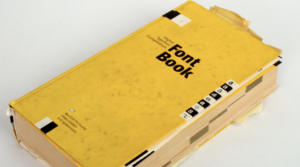In the world of graphic design, typography plays a crucial role in conveying the message, setting the tone, and enhancing the overall visual appeal of a piece. One of the most revered resources in the realm of typography is the “FontBook,” often referred to as the Bible of typography. In this in-depth article, we will explore the significance of the FontBook, its history, content, and how it has become an indispensable tool for designers and typographers worldwide.

FontBook
I. A Historical Overview
The Font, a comprehensive guide to typography, has a rich history that traces back to the origins of typography itself. Typography, the art and technique of arranging type to make written language legible and visually appealing, has evolved over centuries. From Gutenberg’s invention of the printing press in the 15th century to the digital era, the history of typography is intertwined with the history of the FontBook.
II. The Evolution of Typography
-
Pre-Digital Era
- Before the digital age, typographers and designers relied heavily on printed resources for font selection and reference. These resources included printed type specimen books and catalogs, which laid the foundation for the FontBook.
-
The Digital Revolution
- With the advent of computers and digital typography, the need for a digital version of the FontBook became evident. Software developers and typographers joined forces to create a digital FontBook that could be easily accessed and updated.
III. The Content of the FontBook
-
Font Listings
- The core of the FontBook is its extensive collection of typefaces. It provides detailed information on various fonts, including their names, designers, foundries, and classification.
-
Type Specimens
- Type specimens showcase each font’s characteristics, such as letterforms, weights, and styles. These visual representations help designers choose the right font for their projects.
-
Historical Context
- The FontBook often includes historical context about specific typefaces, their designers, and the eras in which they were created. Understanding the origins of a font can help designers use them appropriately in various contexts.
-
Usage Guidelines
- Many FontBooks offer usage guidelines and best practices for working with different typefaces. This information helps designers make informed decisions about typography in their projects.
IV. The Digital Age and Accessibility
-
Digital FontBook
- In the digital age, the FontBook has transitioned from printed volumes to digital databases. These digital versions offer greater accessibility, search functionality, and updates to keep pace with the ever-expanding world of typography.
-
Online Resources
- Online platforms and websites dedicated to typography have become invaluable resources for designers. They offer FontBook-like features, allowing designers to browse and experiment with fonts, access font licenses, and learn more about typography trends.
V. The Influence of FontBook on Design
-
Education and Inspiration
- FontBook has become an essential educational resource for graphic design students and professionals. It serves as a source of inspiration, helping designers discover new fonts and design possibilities.
-
Consistency and Branding
- FontBook aids in maintaining design consistency and effective branding by providing designers with a wide range of typefaces that suit various design needs and contexts.
Conclusion
In the world of typography, the Font stands as a symbol of knowledge and inspiration. From its historical roots in printed type specimen books to its digital evolution, the Typeface Compendium has played a pivotal role in shaping the art of typography. Designers, typographers, and students alike turn to it as an essential reference, guide, and a never-ending source of inspiration. In a digital age where the choice of typefaces seems endless, the Typeface Compendium continues to be a compass that guides designers through the vast and ever-evolving landscape of typography. It remains, in many ways, the Bible of typography, enlightening and inspiring the world of visual communication.

